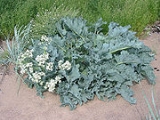
Seakale
Encyclopedia
Crambe maritima is a halophytic
perennial plant
in the genus Crambe
that grows wild along the coasts of Europe
, from the North Atlantic to the Black Sea
. It has large fleshy glaucous collard-like leaves and abundant white flowers. The seeds come one each in globular pods.
The plant is sometimes grown as an ornamental but its most common use is as a blanched vegetable. Along the coast of England, where it is commonly found above High Tide Mark on shingle beaches, local people heaped loose shingle around the naturally occurring root crowns in springtime, thus blanching the emerging shoots. By the early 18th Century it had become established as a garden vegetable, but its height of popularity was the early 19th Century when sea kale appeared in Thomas Jefferson's Garden Book of 1809, and it was served at the Prince Regent's Royal Pavilion
in Brighton. The shoots are served like asparagus
: steamed, with either a bechamel sauce
or melted butter, salt and pepper. It is apt to get bruised or damaged in transport and should be eaten very soon after cutting, this may explain its subsequent decline in popularity. However, given a rich, deep and sandy soil, it is easy to propagate and grow on from root cuttings available from specialist nurseries. Blanching may be achieved by covering it with opaque material or using a deep, loose and dry mulch.
Sea kale is more commonly used in Europe and only rarely grown in the United States
.
Halophyte
A halophyte is a plant that grows where it is affected by salinity in the root area or by salt spray, such as in saline semi-deserts, mangrove swamps, marshes and sloughs, and seashores. An example of a halophyte is the salt marsh grass Spartina alterniflora . Relatively few plant species are...
perennial plant
Perennial plant
A perennial plant or simply perennial is a plant that lives for more than two years. The term is often used to differentiate a plant from shorter lived annuals and biennials. The term is sometimes misused by commercial gardeners or horticulturalists to describe only herbaceous perennials...
in the genus Crambe
Crambe
Crambe is a genus of Brassicaceae native to Europe, southwest and central Asia and eastern Africa. It includes among its species seakale , grown as a leaf vegetable, Crambe cordifolia which is grown as an herbaceous border perennial, and Crambe abyssinica, which is grown for an oil from the seeds...
that grows wild along the coasts of Europe
Europe
Europe is, by convention, one of the world's seven continents. Comprising the westernmost peninsula of Eurasia, Europe is generally 'divided' from Asia to its east by the watershed divides of the Ural and Caucasus Mountains, the Ural River, the Caspian and Black Seas, and the waterways connecting...
, from the North Atlantic to the Black Sea
Black Sea
The Black Sea is bounded by Europe, Anatolia and the Caucasus and is ultimately connected to the Atlantic Ocean via the Mediterranean and the Aegean seas and various straits. The Bosphorus strait connects it to the Sea of Marmara, and the strait of the Dardanelles connects that sea to the Aegean...
. It has large fleshy glaucous collard-like leaves and abundant white flowers. The seeds come one each in globular pods.
The plant is sometimes grown as an ornamental but its most common use is as a blanched vegetable. Along the coast of England, where it is commonly found above High Tide Mark on shingle beaches, local people heaped loose shingle around the naturally occurring root crowns in springtime, thus blanching the emerging shoots. By the early 18th Century it had become established as a garden vegetable, but its height of popularity was the early 19th Century when sea kale appeared in Thomas Jefferson's Garden Book of 1809, and it was served at the Prince Regent's Royal Pavilion
Royal Pavilion
The Royal Pavilion is a former royal residence located in Brighton, England. It was built in three campaigns, beginning in 1787, as a seaside retreat for George, Prince of Wales, from 1811 Prince Regent. It is often referred to as the Brighton Pavilion...
in Brighton. The shoots are served like asparagus
Asparagus
Asparagus officinalis is a spring vegetable, a flowering perennialplant species in the genus Asparagus. It was once classified in the lily family, like its Allium cousins, onions and garlic, but the Liliaceae have been split and the onion-like plants are now in the family Amaryllidaceae and...
: steamed, with either a bechamel sauce
Béchamel sauce
Béchamel sauce , also known as white sauce, is one of the mother sauces of French cuisine and is used in many recipes of Italian cuisine, for example lasagne. It is used as the base for other sauces . It is traditionally made by whisking scalded milk gradually into a white roux...
or melted butter, salt and pepper. It is apt to get bruised or damaged in transport and should be eaten very soon after cutting, this may explain its subsequent decline in popularity. However, given a rich, deep and sandy soil, it is easy to propagate and grow on from root cuttings available from specialist nurseries. Blanching may be achieved by covering it with opaque material or using a deep, loose and dry mulch.
Sea kale is more commonly used in Europe and only rarely grown in the United States
United States
The United States of America is a federal constitutional republic comprising fifty states and a federal district...
.

